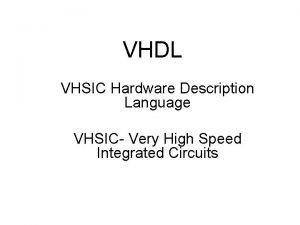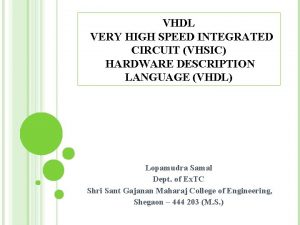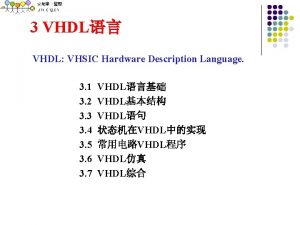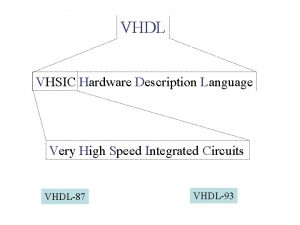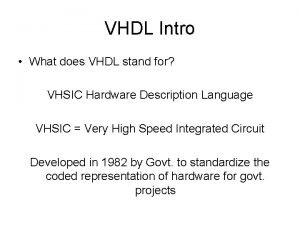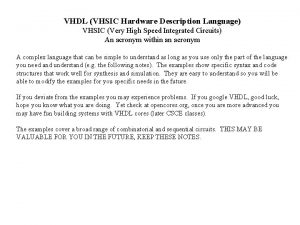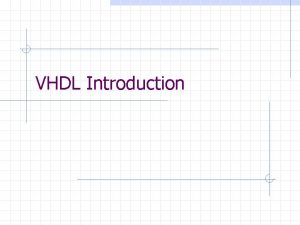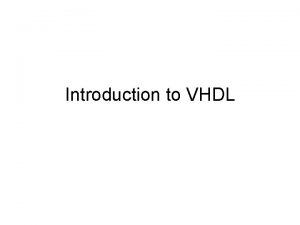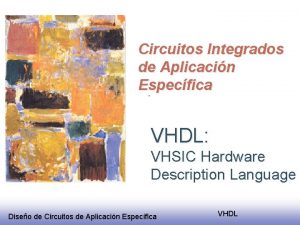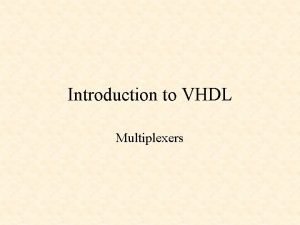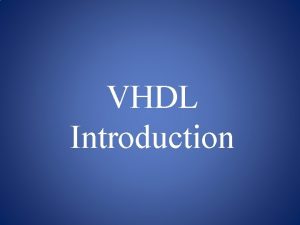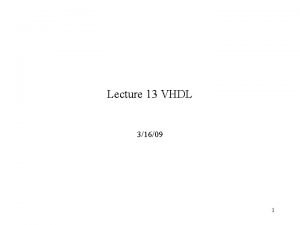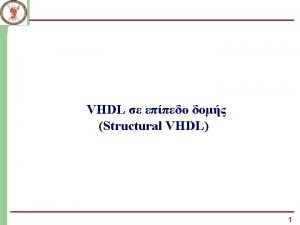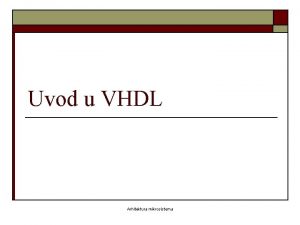VHDL Intro What does VHDL stand for VHSIC
















- Slides: 16

VHDL Intro • What does VHDL stand for? VHSIC Hardware Description Language VHSIC = Very High Speed Integrated Circuit Developed in 1982 by Govt. to standardize the coded representation of hardware for govt. projects

Why use VHDL • VHDL is for coding models of a digital system. . . • Reasons for modeling – – documentation testing using simulation formal verification Synthesis – can optimize designs beyond practical means possible by regular person • Goal – most ‘reliable’ design process, with minimum cost and time – avoid design errors! – Reuse libraries and designs already provided

VHDL Design Process • Write module code • Write a VHDL Driver program (Test. Bench) • Simulation – Simulate your design using Modelsim on your Test. Bench • Synthesis – Synthesize your design using a given set of constraints • Verification (timing, etc) – Verify that the synthesized design works

VHDL Models • Every VHDL model generally consists of one entity declaration – Entity • Name/Identity of the module you want to design • Declares number and types of ports that module uses • Allows the internal algorithm or hardware representation of that entity to separated from its module reference (the entity is the black box)

VHDL Models • VHDL models have one or more Architecture descriptions – The architecture description is the actual implementation of the entity reference (the inside of the black box) – Can have more than one architecture description to handle varying design cases • Example, with a 32 bit adder entity, you can have architecture descriptions for a slow, small carryripple adder, and a faster, bigger carry look ahead

VHDL Models • Architectures for your entities can be coded using three different VHDL language constructs – Behavioral • Sequential statements done in a special VHDL construct called a process – Dataflow • Concurrent assignment statements – Structural • Component instantiation and port mapping

Behavioral • Used to model things that are sequential in nature (sequential logic for example) – Uses the idea of something called a process • A process holds a block of sequential statements inside its code area • A process is only executed when something in its sensitivity list changes – Inside process statement • Can declare variables • Use : = operator with variable assignments • Can use specialized keywords (such as wait, after) to simulate real world delays (example can include a global variable that simulates delay time of basic gates, then simulation timing will be more accurate

Behavioral Example process( S 1, S 2 ) Sensitivity list variable V 1, V 2: BIT; Variable Declarations begin V 1 : = ’ 1’; –– This sets the value of V 1 V 2 : = ’ 1’; –– This sets the value of V 2 V 1 : = ’ 0’; –– This sets the new value of V 1 V 2 : = ’ 0’; –– This sets the new value of V 2 end process;

Dataflow • Used to assign changes concurrently, value gets propagated from input to output whenever input changes • Use the <= operator • Remember, everything happens concurrently • Generally a Dataflow item will synthesize to some sort of memory based hardware (latch or flip flop for clocked processes ) as storage is implied

Dataflow Example library IEEE; use IEEE. std_logic_1164. all; entity simple. And is port ( A: in STD_LOGIC; B: in STD_LOGIC; OUT: out STD_LOGIC ); end simple. And; architecture dataflow. And of simple. And is begin OUT <= A & B; end dataflow. And;

Structural • Used when you want to include other modules in your current design. – First you instantiate a module and give it a unique name – Then you map its input/output ports into your current module using a port map

Structural Example architecture struct of comb_ckt is component AND_GATE is port( A: in std_logic; B: in std_logic; F 1: out std_logic ); end component; -- as entity of AND_GATE component OR_GATE is port( X: in std_logic; Y: in std_logic; F 2: out std_logic ); end component; -- as entity of OR_GATE begin Gate 1: AND_GATE port map (A=>input 1, B=>input 2, F 1=>wire); Gate 2: OR_GATE port map (X=>wire, Y=>input 3, F 2=>output); end struct;

Overall Design • All three different methods of design can be mixed in one architecture block • Example – Finite State Machine Design – Data Flow design used to pick the next state assigned to state storage flip flop – Behavioral process block used to write logic that determines what the next state is

Other VHDL keywords • Signals – Syntax: signal <= value – Used mostly in structural, dataflow designs – Cause simulation events to be created, but they will be handled during the next simulation delta – Can be considered as a wire (with the understanding of how the simulation delta affects it) • Variables – Syntax: var: =expression – Can only be used in processes (behavioral designs) – Do not cause simulation events

Example - Variables • Process statement using variables process (y) variable x, z : bit; begin x: =y; x now has the value of y after this line executes z: =x; z now has the value of x after this line executes end process; • Question: Is z == x ? – Yes, because variables are updated immediately during the CURRENT simulation delta after every assignment

Example -Signals • Process statement using signals … signal x, y, z : bit; … process (y) begin x<=y; x is assigned the value of y as soon as the process starts z<=x; z is assigned the OLD value of x as soon as the process starts end process; • Question: Is z == x ? – NO, because when the assignment x<=y takes place, on the next simulation delta the change of x will be available not in the current simulation delta – z == old value of x
 Vhsic hardware description language
Vhsic hardware description language Very high speed integrated circuit
Very high speed integrated circuit Language
Language Hdl is
Hdl is Vhsic hardware description language
Vhsic hardware description language Vhdl stands for
Vhdl stands for Stand up for jesus
Stand up for jesus Nanny shine has got
Nanny shine has got Formuö
Formuö Novell typiska drag
Novell typiska drag Nationell inriktning för artificiell intelligens
Nationell inriktning för artificiell intelligens Vad står k.r.å.k.a.n för
Vad står k.r.å.k.a.n för Varför kallas perioden 1918-1939 för mellankrigstiden?
Varför kallas perioden 1918-1939 för mellankrigstiden? En lathund för arbete med kontinuitetshantering
En lathund för arbete med kontinuitetshantering Adressändring ideell förening
Adressändring ideell förening Tidbok
Tidbok A gastrica
A gastrica
